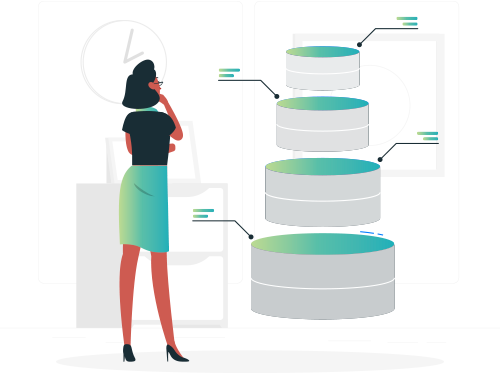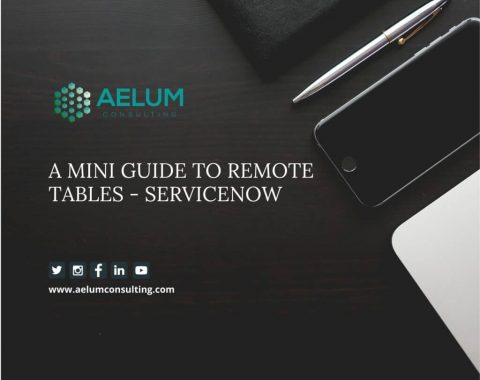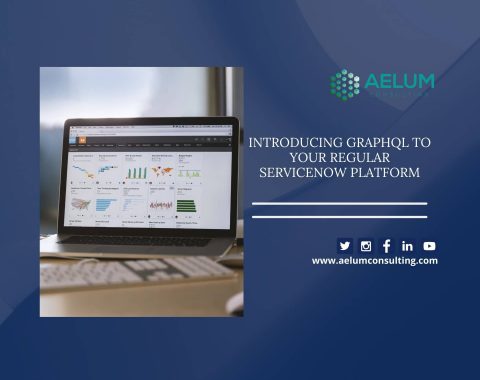Store and Centralize the database about all technical services enabling efficient tracking and management with ServiceNow Configuration Management Database (CMDB).

ServiceNow CMDB
ServiceNow CMDB, which stands for Configuration Management Database, is a powerful IT management tool that provides a single source of truth for an organization’s IT infrastructure. The CMDB enables organizations to track and manage IT assets, services, and their relationships with each other. It helps organizations optimize their IT infrastructure, reduce downtime, and increase efficiency.
It provides a comprehensive solution for IT infrastructure management that helps organizations optimize their IT infrastructure, reduce downtime, and increase efficiency. Its powerful features enable organizations to maintain accurate and up-to-date information about their IT assets and services, track and manage changes to the IT infrastructure, and maintain service availability aligned with business objectives.
How does a CMDB work?
Discovery
Discover all the CIs in the IT environment. It can be done through automated discovery tools that scan the network and collect information about devices, software, and services.
Identification
Once the CIs are discovered, they must be identified and classified. Each CI is given a unique identifier and is classified based on its type, function, and relationship to other CIs.
Relationship mapping
Map the relationships between the CIs. It includes identifying dependencies between CIs, such as which software applications run on which servers or network devices are connected to which switches.
Data collection
Once the CIs and their relationships are identified, additional data is collected about each CI, such as its version, patch level, owner, location, and other attributes.
Data storage
The data collected about the CIs are stored in the CMDB, which serves as a centralized repository for all configuration-related data.
Change management
Manage changes to the IT environment. Before any changes are made, the impact on other CIs in the environment is analyzed using the CMDB. It helps to ensure that changes are made in a controlled and predictable manner.
Reporting and analysis
The CMDB generates reports and analyzes the IT environment. It can include reports on compliance, asset management, capacity planning, and other areas.
Benefits of CMDB
Centralized Repository
The ServiceNow CMDB provides a centralized repository for all the configuration items within an organization’s IT infrastructure. It helps provide a single source of truth for the IT assets to be used for various purposes.
Improved IT Service Management
Manage their IT services by providing accurate and up-to-date information about the IT infrastructure. This information can improve incident management, problem management, and change management processes.
Automated Discovery
The ServiceNow CMDB includes automated discovery tools that identify new configuration items as they are added to the IT infrastructure. It helps to ensure that the CMDB is always up-to-date and accurate.
Integrated Platform
ServiceNow is an integrated platform that includes various IT service management tools. The CMDB is tightly integrated with these tools, which makes it easy to use the information in the CMDB to support other IT management processes.
Customizable Data Model
The ServiceNow CMDB includes a customizable data model that allows organizations to tailor the CMDB to their needs. It helps to ensure that the CMDB is flexible enough to meet the unique requirements of different organizations.
Reporting and Analytics
The ServiceNow CMDB includes reporting & analytics capabilities, allowing organizations to gain insights into their IT infrastructure. It can identify trends, spot potential issues, and make data-driven decisions about IT service management.
CMDB Best Practices
Start with a clear and well-defined CMDB strategy
Define your CMDB objectives, scope, policies, and procedures, and ensure that everyone in your organization understands the importance of accurate and up-to-date CMDB data.
Establish a strong governance framework
Ensure a robust set of policies, procedures, and controls govern the CMDB. Define roles and responsibilities to maintain the CMDB, establish processes, & ensure data accuracy and quality.
Use a consistent data model
Use a consistent data model to ensure accurate and consistent data recording across the CMDB. Define data classes, attributes, and relationships, and use these consistently across all IT assets.
Automate data collection and update processes
Automate data collection and updating from various sources to ensure that the CMDB is accurate and up-to-date. It can include automated discovery tools, other system data feeds, and manual data entry.
Use relationship mapping to understand dependencies
Between different IT assets, applications, and services, use relationship mapping to understand dependencies. It helps to identify potential risks to make informed decisions about changes to the IT environment.
Regularly review and clean up the CMDB
Regularly review the CMDB data to ensure that it is accurate, complete, and up-to-date. Use data quality reports to identify data issues and establish processes for cleaning and maintaining the data.
Characteristics of ServiceNow CMDB
Seamless dashboards
It makes tracking the health of data, the impact of changes, patterns that lead to incidents or problems, and the health of the CIs easy.
Access controls
Get access levels as per their needs with access controls and trace any changes back to the source in the event of incidents or questions.
Compliance
It provides detailed records for better audit visibility and insight into the state of CIs, historical changes, checks and balances, and incidents in the records.
Creation of CIs and data population
Integrations, discovery tools, and manual input methods can help scan IP addresses within an organization’s network to find software and hardware data.
Federated data sets
It supports the federated data sets by including reconciliation and normalization of CIs and their relevant data.
IT service mapping
It helps physically represent relationships and dependencies related to an IT service, outlining how each connects to business services.
Challenges of CMDBs
-
Data Quality
The accuracy and completeness of the data in a CMDB are critical to its usefulness. Ensuring the data is up-to-date, accurate, and complete can be a significant challenge. Organizations must establish processes for collecting and updating data and maintaining its accuracy.
-
Data Volume
The amount of data that needs to be collected and stored in a CMDB can be substantial, especially for large organizations. It can be challenging to manage, as the sheer volume of data can make it difficult to find the information needed to support IT management processes.
-
Integration with Other Systems
To be effective, a CMDB needs to be integrated with other IT management systems, such as asset management and service management tools. It can be challenging, as different systems may use different data models or have different data quality requirements.
-
Complexity
The hierarchical structure of a CMDB and the relationships between configuration items can make it complex to implement and maintain. Organizations must ensure they have the required expertise and resources to manage the complexity of a CMDB.

How Can Aelum Consulting Help with ServiceNow CMDB?
Aelum Consulting can help with ServiceNow CMDB (Configuration Management Database) in the following ways:
Implementation and Configuration
Aelum Consulting can help with the initial implementation and configuration of ServiceNow CMDB. Our team of experts will work with you to ensure that the CMDB is configured to meet your organization’s specific needs.
Data Normalization
Aelum Consulting can help with data normalization to ensure that the data in the CMDB is consistent, accurate, and up-to-date. It involves analyzing data from various sources, identifying inconsistencies, and resolving them to ensure the CMDB accurately represents your IT environment.
Automation
Aelum Consulting can help automate the population of the CMDB with data from various sources, such as discovery tools, monitoring tools, and other systems. This automation ensures that the CMDB is always up-to-date and reflects the current state of your IT environment.
Integration
Aelum Consulting can help integrate the CMDB with other ServiceNow modules and third-party tools, such as ITSM, ITOM, and ITAM. This integration ensures the CMDB is a central repository for all IT data and enables seamless data sharing between different IT functions.
Governance and Best Practices
Aelum Consulting can help establish governance policies and best practices for the CMDB, ensuring that the data in the CMDB is accurate, consistent, and up-to-date. We can also provide training to your team to ensure they have the knowledge and skills to maintain the CMDB effectively.
CMDB Health Check
Aelum Consulting can perform regular health checks on your CMDB to identify any issues or inconsistencies and ensure it functions optimally. It involves analyzing the data in the CMDB, identifying gaps, and making recommendations for improvements.
Why is CMDB critical for effective ITAM?
A Configuration Management Database (CMDB) is critical for effective IT Asset Management (ITAM) for several reasons:
Centralized data
A CMDB provides a centralized data repository for all IT assets and configurations. It makes it easier for ITAM teams to track and manage assets across the organization and ensures that all asset data is consistent and up-to-date.
Accurate inventory tracking
A CMDB enables ITAM teams to accurately track hardware and software inventory, including purchase date, location, and usage. It helps organizations to optimize asset utilization, reduce asset downtime, and avoid over- or under-provisioning.
Dependency mapping
A CMDB allows ITAM teams to map dependencies between IT assets, apps, and services. Organizations understand how IT assets are used and how they impact other parts of the IT infrastructure to plan and manage changes to the IT infrastructure.
Compliance management
A CMDB can help organizations manage software license compliance by tracking software installations, usage, and agreements. It ensures that the organization uses software to comply with vendor licenses and can help avoid costly license audits and penalties.
Cost optimization
By having a complete and accurate view of IT assets and their configurations, ITAM teams can better optimize asset usage, reduce asset downtime, and avoid over-provisioning. It can help organizations to reduce IT costs and improve overall cost-effectiveness.
Frequently Asked Questions
When setting up a Configuration Management Database (CMDB), it is crucial to determine which entities to manage in the database. These entities can be broadly classified into technical and non-technical entities, and both entities play an essential role in maintaining a comprehensive and accurate CMDB.
Technical entities are IT assets that build and maintain an organization’s IT infrastructure. They can include hardware devices, such as servers, switches, routers, software applications, operating systems, and databases. Technical entities are typically easier to manage within a CMDB as they have well-defined attributes and relationships.
On the other hand, non-technical entities include information that is not directly related to IT infrastructure but is still essential for maintaining a comprehensive CMDB. These entities can include organizational structures, such as departments, teams, locations, business processes, policies, and contracts. Non-technical entities can be more challenging to manage within a CMDB as they may have more complex relationships and attributes.
By considering these pointers, organizations can create a comprehensive and accurate CMDB that includes all relevant entities to maintain their IT infrastructure. Also, it ensures that the CMDB is not overly complex or challenging to maintain.
Here’s a comparison chart of some of the key differences between ITAM and CMDB:
| Category | ITAM | CMDB |
| Focus | Managing IT assets | Managing the relationships between IT components |
| Scope | Lifecycle management of hardware and software assets | Inventory and configuration management of IT infrastructure components |
| Purpose | Maximizing asset value and optimizing usage | Providing a centralized source of truth for IT assets and their dependencies |
| Key Features | Asset inventory tracking, asset lifecycle management, software licensing compliance, cost analysis | Configuration item (CI) tracking, relationship mapping, dependency management, service impact analysis |
| Usage | Used to optimize asset utilization and cost-effectiveness. | Used for incident management, change management, and service management. |
| Examples. | Tools like SolarWinds SAM, ServiceNow ITAM, and Ivanti IT Asset Management. | Tools like ServiceNow CMDB, BMC Helix CMDB, and Freshworks CMDB. |
It’s important to note that while there are differences between ITAM and CMDB, they are not mutually exclusive. In fact, many organizations use both ITAM and CMDB tools in tandem to get a complete picture of their IT assets and infrastructure.
CSDM and CMDB are related concepts in IT Service Management (ITSM) and IT Asset Management (ITAM), but they serve different purposes.
CSDM stands for Common Services Data Model, a ServiceNow-specific data model that provides a standard framework for organizing and managing information about IT services, assets, and relationships. CSDM is intended to help organizations better understand the dependencies and relationships between IT services, applications, and infrastructure components.
On the other hand, a CMDB (Configuration Management Database) is a general term that refers to a centralized repository for IT assets and configuration data. A CMDB can contain various information about IT assets, such as hardware and software configurations, version information, and relationships between assets. The purpose of a CMDB is to help organizations manage their IT assets and ensure that they are being used efficiently and effectively.
While a CMDB can be part of a CSDM implementation, CSDM is a more comprehensive framework that includes not only a CMDB. But other data models and tools also enable organizations to manage their IT services and assets more effectively. CSDM provides a more holistic view of the IT environment and helps organizations understand the relationships and dependencies between different IT components.
In conclusion, a CMDB is a centralized repository for IT assets and configuration data. At the same time, CSDM is a ServiceNow-specific data model that provides a framework for organizing and managing information about IT services, assets, and relationships. While a CMDB is just one component of a CSDM implementation, CSDM provides a more comprehensive framework for managing IT services and assets.
Our Clients


























































